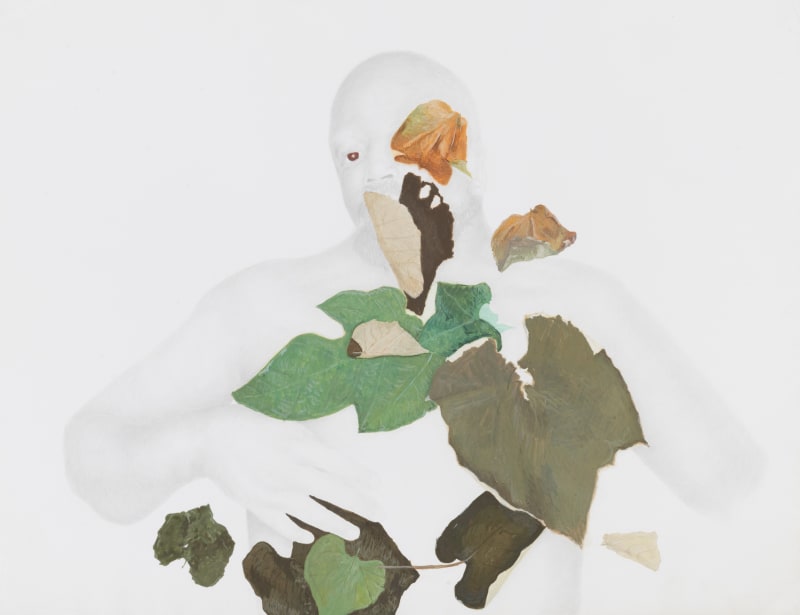Welancora Gallery is pleased to present Metamorphoses | Μεταμορφώσεις, a solo presentation of a suite of self portraits and other works on paper and panel by Darryl Keith Babatunde Smith. This exhibition will be on view from June 13 to July 25, 2024. The opening reception will take place on Thursday, June 13 from 6pm-8pm.
The title of the show takes its name from Ovid’s 8 CE epic, Metamorphoses, which tells the story of the creation of the world to Julius Caesar’s death. The poem utilizes real events and mythology to confront issues related to transformation and love. Babatunde Smith’s extensive research and mastery of linguistics and classical studies provide the basic framework for the works in the show, as he utilizes myth and language as a way to understand his journey as a queer Black man. In the same way that one myth flows into another in Ovid’s epic, transformations occur across and throughout Smith’s works, each of which is a representation of a state of time and being in his life. Closely following the era of Greek and Roman antiquity, Smith refers to marble statues and black-figure/red-figure vase paintings, both of which have occasionally represented African people. Smith’s works utilize metalpoint (24 karat goldpoint and silverpoint), gold leaf, and egg tempera, the delicacy and softness of which further lend themselves to the artist’s self-healing, vulnerability, and reclamation of space through portraiture.
Creating his own origin story and narrative, Smith’s works centralize kára – the ancient Greek word for the head or face, but simultaneously indicative of ones’ fuller essence. To develop his ‘vase characters’ and display their inner emotions, color becomes key. Red faces are reminiscent of negative experiences, told through Ovid’s prominent myths of Medusa and Orpheus; the color black becomes grounded in a strong, stoic, but positive identity; and off-white acts as an embodiment of Smith’s spirit.
With his piece To Asterius (to the stars) | εἰς Ἀστέριον (ad astra), Smith juxtaposed his experience as a Black American man with the myth of the Minotaur. Described in Ovid’s Metamorphoses as ‘half man half bull’, this widely known description leaves out the creature’s true name – Asterius, meaning ‘starry’. As a token of empathy, Smith uses Asterius’ name for the figurative metalpoint self portrait. By donning a bull mask and positioning himself in a curled up pose–that is both self protective and introspective—Smith displays the eerie similarities between the gaze casted upon African American men and the Minotaur, neither of whom have been fully humanized.
In contrast, the artist’s depiction of the specifically queer Black male experience takes a lighter departure in other works. In the garden | ἐν κήπῳ sees Smith covered in ivy, vines, and grape leaves as an allude to a newfound autodidactic freedom born out of self love and self discovery. Dionysos, the Greek god of wine, revelry and theater, who is recognized as a queer deity, is associated with the same liberating foliage. As Smith looks out at the viewer past the green and gold leaves adorning his body, he radiates light and joy. Nothing but y’all’s face (Epilogue) | Nil nisi vultus vestri (Epilogus) returns to centering kára for the end of Smith’s narrative, closing with notes of relief and reflection. To peer into the golden mirror is to see and uphold oneself through the same sophisticated lens that exists in classical Greek art. This final action, coupled with the representation of Black bodies in Greek antiquity, is a move towards visual decolonization and emphasizing the multicultural history of ancient Greece.
Much like Fred Wilson’s practice, the works in this exhibition question who is visible in the art historical canon. Smith’s highly detailed and realistic studies of human anatomy challenge the negative perception of Black men by presenting and treating them in an elegant manner antithetical to their reality. The conviction of each stance within his portraits lend themselves to the same presence that is felt in Greek marble sculptures, but Smith’s light and airy figures highlight a calm and quiet, yet self-assured, existence. In Smith’s own words:
“I am Melanated marble. The one that stood next to Parian marble, the one Vesuvius buried, the one resurrected, the one conquered and effaced, destroyed then rewritten. My marble veins, ever-present.”


